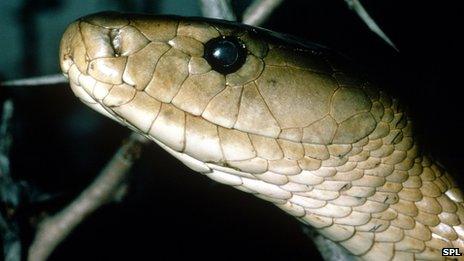Black mamba venom is 'better painkiller' than morphine
- Published

A painkiller as powerful as morphine, but without most of the side-effects, has been found in the deadly venom of the black mamba, say French scientists.
The predator, which uses neurotoxins to paralyse and kill small animals, is one of the fastest and most dangerous snakes in Africa.
However, tests on mice, reported in the journal Nature, showed its venom also contained a potent painkiller.
They admit to being completely baffled about why the mamba would produce it.
The researchers looked at venom from 50 species before they found the black mamba's pain-killing proteins - called mambalgins.
Dr Eric Lingueglia, from the Institute of Molecular and Cellular Pharmacology near Nice, told the BBC: "When it was tested in mice, the analgesia was as strong as morphine, but you don't have most of the side-effects."
Morphine acts on the opioid pathway in the brain. It can cut pain, but it is also addictive and causes headaches, difficulty thinking, vomiting and muscle twitching. The researchers say mambalgins tackle pain through a completely different route, which should produce few side-effects.
He said the way pain worked was very similar in mice and people, so he hoped to develop painkillers that could be used in the clinic. Tests on human cells in the laboratory have also showed the mambalgins have similar chemical effects in people.
But he added: "It is the very first stage, of course, and it is difficult to tell if it will be a painkiller in humans or not. A lot more work still needs to be done in animals."
Mamba magic
Dr Nicholas Casewell, an expert in snake venom at the Liverpool School of Tropical Medicine, has recently highlighted the potential of venom as a drug source.
Commenting on this study he said: "It's very exciting, it's a really great example of drugs from venom, we're talking about an entirely new class of analgesics."
Dr Lingueglia said it was "really surprising" that black mamba venom would contain such a powerful painkiller.
Dr Casewell agreed that it was "really, really odd". He suggested the analgesic effect may work in combination "with other toxins that prevent the prey from getting away" or may just affect different animals, such as birds, differently to mice.
The Royal Pharmaceutical Society's Dr Roger Knaggs said: "We are witnessing the discovery of a novel mechanism of action which is not a feature of any existing painkillers."
He cautioned that the mambalgins worked by injections into the spine so would need "significant development" before they could be used in people.
- Published19 September 2012
- Published27 September 2012
- Published5 February 1999